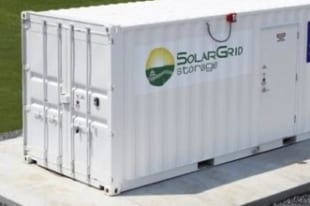 This week’s Intersolar North America conference, the world’s largest solar power confab, has dedicated multiple tracks of its multi-day schedule to energy storage. That’s a lot more attention than the single, hour-long sessiondedicated to marrying batteries with solar panels at last year’s show. But it’s in keeping with the rise in interest, and investment, into storage-backed solarover the last twelve months.
This week’s Intersolar North America conference, the world’s largest solar power confab, has dedicated multiple tracks of its multi-day schedule to energy storage. That’s a lot more attention than the single, hour-long sessiondedicated to marrying batteries with solar panels at last year’s show. But it’s in keeping with the rise in interest, and investment, into storage-backed solarover the last twelve months.
That interest brought a standing-room-only audience to a panel on storage’s prospects, which covered the market drivers, regulatory pressures, international developments and still-remaining cost and bankability pressures facing the companies and customers that would bring battery-backed solar power to the mainstream.
The cost side was addressed by Michael Starke, electrical engineering researcher with the Department of Energy’s Oak Ridge National Laboratory (ORNL). DOE is supporting research that aims to drive the cost of grid-scale energy storage technology to less than $100 per kilowatt-hour — a tenfold decrease from today’s typical costs of $1,000+ per kilowatt-hour.
Most of today’s grid-scale storage projects have used either sodium-sulfur batteries (which have good multi-hour storage characteristics but run at extremely high temperatures) or lithium-ion batteries, which tend to be better suited to power applications like regulating grid frequency or temporarily reducing loads on stressed power lines.
Certain technologies, such as flow batteries, aqueous sodium-ion batteries, and systems that combine aspects of capacitors with electrochemical storage, are pushing that kilowatt-hour cost barrier, noted Starke. Flow batteries, for instance, can increase their energy capacity, or kilowatt-hour rating, simply by adding more tanks for the electrolyte that serves as their storage medium, in contrast to “closed” batteries that contain a fixed amount of electrolyte per cell.
But new battery chemistries aimed specifically at the grid may see stiffer competition from lithium-ion battery makers in future years, as the market for electric vehicles grows the market for bigger batteries and drives economies of scale. In fact, one of the key cost reductions for grid-scale storage is likely to come from “secondary-use” batteries taken out of EVs and put into grid formats, Starke said.
ORNL launched just such a project with General Motors and grid giant ABB in 2012 to see how Chevy Volt batteries could be repurposed for solar smoothing and energy shifting, he said. A similar project featuring BMW and inverter maker Princeton Power is underway in California.
But the biggest market driver for EV-to-grid battery growth is likely to be China, said Bob Gaylen, CTO of Hong Kong-based lithium-ion battery maker Amperex Technology. The company, founded in 1999 to serve the consumer electronics market, launched its EV and stationary energy storage group in 2007, and in 2011 deployed a 16-megawatt-hour system for State Grid Corp. of China, the country’s massive state-owned utility.
China will need a lot more energy storage, both for its massive solar and wind farms in its western reaches and for the increasing amount of distributed solar PV it’s deploying in more populous areas, he said.
“China will start subsidizing grid-connected storage,” said Gaylen. “Then we’ll get a very large demand coming out of China for stationary systems. So we see these two trends converging very well.”
Amperex, which already churns out megawatts of batteries per month for electric buses and other EVs in China, is also making cabinet-sized battery-inverter combinations to deploy in buildings, and “you’ll get these systems making their way into shelves and racks that will be deployed here in the U.S. and around the world,” he said.
Talking about battery costs doesn’t necessarily address the question of how they’re going to earn money on the grid, however. Regulations are critical in driving grid-scale energy storage to market, whether it’s through mandates in California, grid interconnection requirements in Hawaii and Puerto Rico, or economic incentives tied to making solar PV into a more stable, dispatchable resource.
Charlie Vartanian, marketing director at flow battery maker UniEnergy Technologies, noted that most of the regulatory drivers for energy storage today tend to be of the “sticks” variety, with Puerto Rico’s mandate for minimum storage for any new solar and wind power projects being a good example.
But “in Hawaii, I’ve seen some model PPAs [power purchase agreements] where instead of sticks, they’re going to carrots” through renewable power solicitations that have offered premium payments for storage-firmed energy, he added.
As for how utilities are monetizing these energy storage resources, “the initial focus has been as a resource alternative” — in other words, as a replacement for a traditional generation resource.
That includes ancillary services like frequency regulation, as well as “the capacity they’d otherwise purchase through the markets, they will directly provide or contract through energy storage.”
But moves underway in California and other key markets could create more roles for storage that meets multiple grid needs, such as transmission and distribution grid capacity mitigation and voltage management on PV-impacted grid circuits.
Source: Greentech Media. Reproduced with permission.










